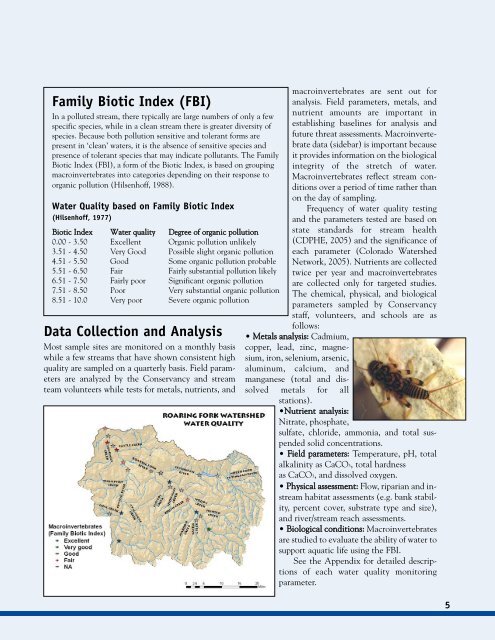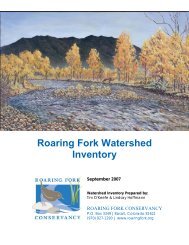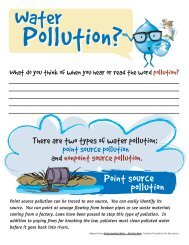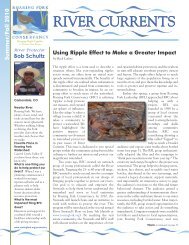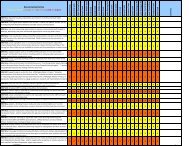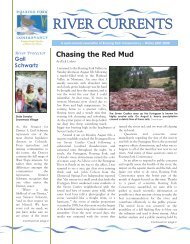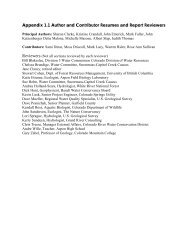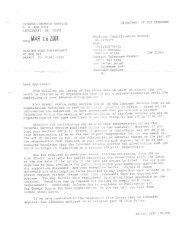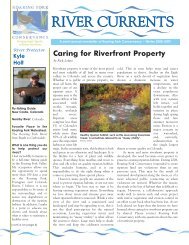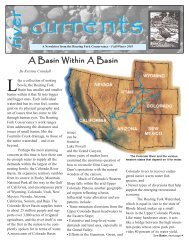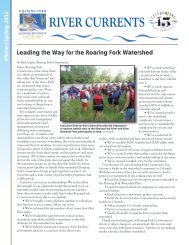2006 Roaring Fork Watershed Water Quality Report
2006 Roaring Fork Watershed Water Quality Report
2006 Roaring Fork Watershed Water Quality Report
- No tags were found...
You also want an ePaper? Increase the reach of your titles
YUMPU automatically turns print PDFs into web optimized ePapers that Google loves.
Family Biotic Index (FBI)In a polluted stream, there typically are large numbers of only a fewspecific species, while in a clean stream there is greater diversity ofspecies. Because both pollution sensitive and tolerant forms arepresent in ‘clean’ waters, it is the absence of sensitive species andpresence of tolerant species that may indicate pollutants. The FamilyBiotic Index (FBI), a form of the Biotic Index, is based on groupingmacroinvertebrates into categories depending on their response toorganic pollution (Hilsenhoff, 1988).<strong>Water</strong> <strong>Quality</strong> based on Family Biotic Index(Hilsenhoff, 1977)Biotic Index <strong>Water</strong> quality Degree of organic pollution0.00 - 3.50 Excellent Organic pollution unlikely3.51 - 4.50 Very Good Possible slight organic pollution4.51 - 5.50 Good Some organic pollution probable5.51 - 6.50 Fair Fairly substantial pollution likely6.51 - 7.50 Fairly poor Significant organic pollution7.51 - 8.50 Poor Very substantial organic pollution8.51 - 10.0 Very poor Severe organic pollutionData Collection and AnalysisMost sample sites are monitored on a monthly basiswhile a few streams that have shown consistent highquality are sampled on a quarterly basis. Field parametersare analyzed by the Conservancy and streamteam volunteers while tests for metals, nutrients, andmacroinvertebrates are sent out foranalysis. Field parameters, metals, andnutrient amounts are important inestablishing baselines for analysis andfuture threat assessments. Macroinvertebratedata (sidebar) is important becauseit provides information on the biologicalintegrity of the stretch of water.Macroinvertebrates reflect stream conditionsover a period of time rather thanon the day of sampling.Frequency of water quality testingand the parameters tested are based onstate standards for stream health(CDPHE, 2005) and the significance ofeach parameter (Colorado <strong><strong>Water</strong>shed</strong>Network, 2005). Nutrients are collectedtwice per year and macroinvertebratesare collected only for targeted studies.The chemical, physical, and biologicalparameters sampled by Conservancystaff, volunteers, and schools are asfollows:• Metals analysis: Cadmium,copper, lead, zinc, magnesium,iron, selenium, arsenic,aluminum, calcium, andmanganese (total and dissolvedmetals for allstations).•Nutrient analysis:Nitrate, phosphate,sulfate, chloride, ammonia, and total suspendedsolid concentrations.• Field parameters: Temperature, pH, totalalkalinity as CaCO3, total hardnessas CaCO3, and dissolved oxygen.• Physical assessment: Flow, riparian and instreamhabitat assessments (e.g. bank stability,percent cover, substrate type and size),and river/stream reach assessments.• Biological conditions: Macroinvertebratesare studied to evaluate the ability of water tosupport aquatic life using the FBI.See the Appendix for detailed descriptionsof each water quality monitoringparameter.5


